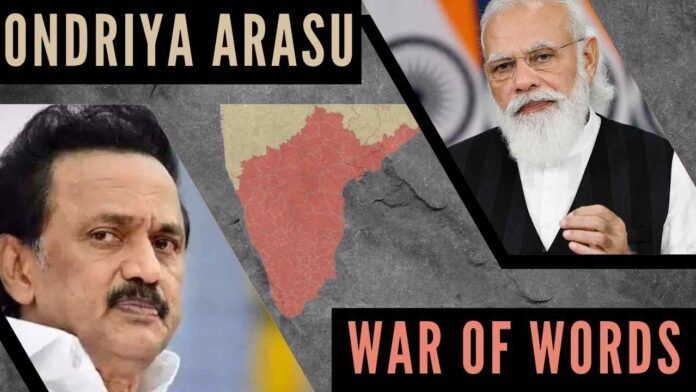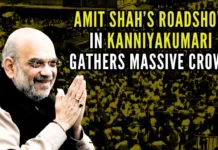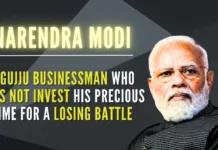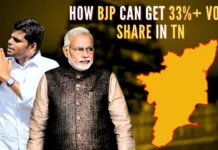
From Mathiya Arasu, to Ondriya Arasu
Tamil Nadu, a South Indian state went for the 16th Legislative Assembly elections in April 2021. The Dravida Munnetra Kazhagam (DMK) under the leadership of Mr. M K Stalin emerged victorious and assumed office on May 7, 2021. The political game in the state started to witness many twists and turns ever since the DMK government assumed office. The word “Ondriya Arasu” (Union Government) came back to usage. The former Chief Ministers of Tamil Nadu (Late) Mr. C N Annadurai and (Late) Mr. M Karunanidhi used the term ‘Ondriya Arasu’ to address Central Government instead of using the term “Mathiya Arasu” (Central Government).
The reason for DMK to address Central Government as Union Government is to highlight that the Central Government in New Delhi is not superior to the State Governments and State governments have rights and powers. The continued usage of this term, in the long run, will create an impression amongst the public that the government in New Delhi is a government (administrative body) formed by the States of India and diluting its role to mere coordination body for the states. This has created a cold war between Central and Tamil Nadu state Governments.
DMK’s demand for Dravida Nadu:
Justice Party (officially South Indian Liberation Federation) was a political party in the Madras Presidency of British India. In 1944 (Late) E V Ramaswamy popularly known as ‘Periyar’ converted the party into a Social Organization under the nomenclature ‘Dravidar Kazham’ (DK) and withdrew from electoral politics. In 1949 (Late) Mr. C N Annadurai and his followers came out of DK and started ‘Dravida Munnetra Kazhagam’ (DMK) for electoral politics. Right from the days of the Justice party the Dravidian movement is advocating for the hypothetical sovereign state of “Dravida Nadu” which will encompass entire South India and some parts of Sri Lanka. However, owing to Tamil hegemony it did not evoke any response from the other South India States.
In 1963, on the recommendation of the Committee on National Integration and Regionalism of the National Development Council, the Parliament of India unanimously passed the Sixteenth Constitutional Amendment which sought to prevent fissiparous, secessionist tendency based on regional and linguistic chauvinism. Since secessionism became illegal, DMK dropped its demand for separate ‘Dravida Nadu’ from its party ideology albeit it took shelter under the Chinese aggression as a reason for the change in its stand.
Revival of secessionism in a Democratic way
After the death of Mr. C N Annadurai in February 1969, the DMK government with Mr. M Karunanidhi as Chief Minister revived secessionist policy. This time the party cleverly took a legalized way by proposing amendments to the Indian Constitution to shift the powers in favor of the states.
In 1969 Tamil Nadu government appointed a three-member committee under the Chairmanship of Dr. P V Rajamannar who was first Chief Justice of Madras High Court in Independent India and was Governor of Madras State from 1957 to 1958. The committee was to examine the entire Centre and State relations and to suggest constitutional amendments to secure utmost autonomy to the states.
The committee submitted its report in 1971 and Some of the recommendations are:
- Setting up a permanent interstate council.
- Finance Commission to be a permanent body.
- Abolition of Planning Commission and a statutory body in its place
- Abolition of Art 356, 357 & 365 in the constitution which deal with the imposition of President Rule for states.
- A portion of Art 164(1) of the constitution stating that council of ministers shall hold office during the pleasure of Governor to be omitted.
- Certain Subjects in Union List and Concurrent List to be transferred to State List.
- Residuary Powers to be allocated to States (from Centre).
- Abolition of All India Services.
The Central government under illustrious Prime Minister Mrs. Indira Gandhi rejected Dr. Rajammannar Committee Recommendations in toto.
DMK‘s justification for “ONDIRYA ARSU”
Recently, DMK justified that its usage of “Ondriya Arsu” i.e., Union Government as the right terminology and is in line with the Constitution of India. Its leaders repeatedly cited Article 1 of the Constitution.
The terminology “Central Government” is nowhere used in the Constitution. This usage has come more by convention rather than by constitutional prescription.
The Indian public suspects the DMK’s intention behind the usage of the term “Union Government” due to its past demand for separate sovereign Dravida Nadu and its failed attempt in 1971 to reduce the Central Government at New Delhi to a mere figurehead by diluting its powers through the tumultuous and sweeping changes to the Indian Constitution recommended by Dr. Rajamannar Committee under the guise of strengthening Centre-State relations.
The suspicion is further amplified by the Tamil Nadu State Finance Minister Mr. PTR Palanivel Thiagarajan’s utterance in the 43rd Goods and Services Tax Council holden on 28th May 2021. He mentioned:
“it is worth remembering that there is no Union without States. As much as the Union is integral (in bringing together One Nation), it is also a Derivative (Citizens, Elected Representatives, and even Officers of the Government, each come from a State). There are no Union Voters”.
“Every minister in this room, including Mrs. Sitharaman (Hon’ble Finance Minister of India), has been elected directly or indirectly by voters within one state; there is no Union Administrative Service and every IAS officer “in this room” has come on deputation from some state.
His statement that “there are no Union Voters” is either a malicious statement highlighting the height of fissiparous tendency, or he is completely ignorant of Citizenship and the Constitution of India.
From the above three constitutional questions are put before the nation? They are:
- Whether Indian Union is an integration of States or States an integral part of the Indian Union?
- Are Voters, Union Voters, or State Voters?
- “Central Government Or “Union Government” which is the correct usage?
We shall answer all three questions by examining our Constitution and its history.
Whether Indian Union is an integration of States or States an integral part of Indian Union?
- Article 1 of the Indian Constitution defines the name and territory of the Union.
- Article 1 (1) “India, that is, Bharath shall be Union of States.
- Article 1 (2) “ The States & territories thereof shall be as specified in the First Schedule”
- Article 1 (3) The territory of India shall comprise –
- (a) The territories of the States.
- (b) The Union territories specified in the First Schedule.
- (c) Such other territories as may be acquired.
For me, the word “Union” in Art 1 does not carry the simple English Dictionary meaning “JOINING” OR “FUSSION”. What it really means is THE WHOLE OF INDIA.
My reasoning comes from the wordings in the Preamble of our constitution.
The preamble of Indian Constitution reads as:
“WE THE PEOPLE OF INDIA, having solemnly resolved to constitute India into a Sovereign, Socialist Secular Democratic Republic and to secure to all its citizens Justice, Liberty, Equity and Fraternity.”
Therefore, in the preamble itself, India is constituted (as a whole). The word ‘constitute’ here means “establish/ form/ install’. That is why the heading of Article 1 is given as Name and Territory of the Union.
If Union is an integration of States, Constitution would not have given the power to Parliament of India in Article 3 to alter the boundaries of areas, boundaries, or names of existing states and formation of new states.
Let us also look at UAE and USA Constitutions for comparison.
The preamble of the United Arab Emirates (UAE) Constitution reads as follows:
“We the Rulers of the Emirates of Abu Dhabi, Dubai, Sharjah, Ajman, Umm al Qaiwain, Ras al Khaimah and Fujairah:
Whereas it is our desire and the desire of the people of our Emirates to establish a Union between these Emirates, to promote a better life, more enduring stability, and a higher international status for the Emirates and their people
Desiring to create closer links between the Arab Emirates in the form of an independent, sovereign, federal state, capable of protecting its existence and the existence of its members, in cooperation with the sister Arab States and with all other friendly states which are members of the United Nations organization and members of the family of nations in general, on the basis of mutual respect and reciprocal interest and advantage”.
The preamble of the United States of America (USA) Constitution reads as follows:
“We the people of the United States, in order to form a more perfect union, establish justice, insure domestic tranquility, provide for the common defense, promote the general welfare, and secure the Blessings of Liberty to ourselves and our Posterity, do ordain and establish this Constitution for the United States of America”.
In the case of UAE, each Emirate is a sovereign member state of UAE whereas the Indian states are not sovereign and the only Indian Republic is Sovereign. The Indian States are divisions created for better administration.
In the case of the USA, the states have their own constitution in addition to the USA constitution. The states have united to meet the common interest mentioned in the preamble. Also, the states can’t opt out of the USA.
Indian constitution has prescribed three tire administrative structures. Parliament at the national level, Legislature at State level, and Panchayat Raj at local government level.
At the top of the pyramid comes Union (Whole of India) Part V of the Constitution, Middle of the pyramid is covered with Part 6 &7 of the constitution for States and Part 8 of the constitution for Union Territories. The bottom of the pyramid covers the administration of local governments Part 9 (Panchayat), Part 9A (Municipalities), Part 9B (Cooperative societies), and Part 10 (Scheduled and Tribal Areas) of the constitution.
Looking through the prism of Indian Independence and the formation of the Republic, we will understand the states of India as they exist today are not the same at the time of Independence.
The Government of India Act 1935 proposed for a Federation of India under the British Crown consisting of:
- Provinces (Governors’ Provinces).
- The Indian States that have acceded or that may thereafter accede to Federation.
The Executive Head of the Governors’ Provinces as the name indicates will be a Governor appointed by His Majesty under the Royal Sign Manual. Eleven Governors Provinces were proposed to be created namely Bombay, Bengal, United Provinces, Punjab, Bihar, Central Provinces, and Berar, Assam, Northwest Frontier Province, Orissa, and Sind.
Burma ceased to be a part of India through the Government of India Act 1935.
The Indian States mean the princely states of India like Mysore, Travancore state, etc., which will join the federation through an instrument of accession.
India Independence Act, 1947 passed by Parliament of United Kingdom on 18th July 1947 provided for setting up of two Dominion States Viz., India and Pakistan from 15th August 1947. Clause 2 of the Act mentioned that the territory of India will include the entire territory of British India before 15th August 1947 excluding the territories going to Pakistan.
Territories of Pakistan will include the provinces of East Bengal, West Punjab, Sind, and Balochistan.
Thus, Bengal Province and Punjab ceased to exist. Both became two provinces. West Bengal and East Punjab came to India while East Bengal and West Punjab went to Pakistan. Similarly, the district of Sylhet was ceded from Assam and joined with the newly created East Bengal Province.
With lapsing of Suzerainty of His Majesty over the Indian States, they had an option to join either of the Dominion Viz., India/ Pakistan, or remain independent. Sardar Vallabhbhai Patel and V P Menon through their diplomatic efforts made the rulers of the states to sign two documents namely Stand Still Agreement and Instrument of Accession. The former confirmed the continuance of pre-existing administrative practices, while the latter is an agreement to the accession of his kingdom to Independent India. The smaller states which were not viable administrative units were either merged with neighboring provinces or joined with another princely state to form a “Princely Union”. All these happened with merger agreements with the ruler. Thus, there was a complete reorganization of states before the Constitution of India came into force and we became one whole piece of the Indian Republic or Bharath.
Now it is amply clear that the states in India are not separate sovereign states. They are viable administrative units. That is why the fathers of the constitution gave permission to Parliament to alter the name, boundary of states or form new states.
Hence, “UINON” MEANS WHOLE OF INDIA. UNION HAS STATES AND UNION TERRITORIES AS ADMINISTRATIVE UNITS.
Are voters union voters or State voters?
To cast a franchise the voter should be registered in the electoral roll of his constituency. Sec 19 of Representation of People Act, 1950 says every person who is not less than 18 years of age and ordinarily resident in a constituency shall be registered in the electoral roll of that constituency. Sec 17 and Sec 18 inform no person is entitled to be registered in the electoral roll of more than one constituency and not more than once in any constituency.
Sec 16(1) of the act prescribes disqualification for registration in the electoral roll. Which says:
A person shall be disqualified for registration in an electoral roll if he —
- Is not a citizen of India; or
- Is of unsound mind and stands so declared by a competent court; or
- Is for the time being disqualified from voting under the provisions of any law relating to corrupt practices and other offences in connection with the election.
Therefore, the foremost condition is, the voter should be a citizen of India and completed 18 years of age.
Part II of the Constitution of India covering Articles 5 to 11 discuss citizens of India. The Constitution does not speak about State Citizenship.
I am born in Tamil Nadu. For employment reasons I migrated to Walayar, Palakkad District in Kerala, and started living there. Being ordinarily a resident in Kerala, I can register in the electoral rolls of the Malampuzha Assembly Constituency under which Walayar Panchayat falls. I can vote for Walayar Panchayat elections, Kerala Assembly Election (Malambuzha constituency), and the Indian Parliament Election for Palakkad Lok Sabha Constituency (Malambuzha Assembly constituency falls under Palakkad Lok Sabha constituency).
Hence the voters are Union of India voters and he exercises his franchise for Parliament, State Assembly, or Local body election from the constituency where he has enrolled himself.
Which is correct usage Central Government or Union Government?
My examination of the Constitution of India says both the terms are incorrect. These two usages have come by convention and not through the Constitution. The terminology used in the Indian Constitution is “GOVERNMENT OF INDIA”. The citations presented below justifies my reasoning.
Part III- Fundamental Rights – Article 12
In this part, unless the context otherwise requires ‘the state’ includes Government and Parliament of India and Government and Legislature of each States and local or other authorities within the territory of India or under the control of Government of India.
Part V – Union – Article 58(2)
A person shall not be eligible for election as President if he holds any office of profit under the Government of India or the Government of any State or under any local or other authority subject to the control of State Governments.
Part V – Union – Article 66(4)
A person shall not be eligible for election as Vice President if he holds any office of profit under the Government of India or the Government of any State or under any local or other authority subject to the control of State Governments.
Part V – Union-Article 76(2)
It shall be the duty of the Attorney General to give advice to the Government of India upon such matters…..
Part V – Union – Conduct of Government – Article 77(1)
All executive action of the Government of India shall be expressed to be taken in the name of the President.
Part V – Union – Conduct of Government – Article 77(3)
The President shall make rules for the more convenient transaction of the business of the Government of India and for allocation among Ministers of said business….
Part V – Union – Original Jurisdiction of Supreme Court – Article 131
Subject to the provisions of this Constitution, the Supreme Court shall, to the exclusion of any other court, have original jurisdiction in any dispute (a) between the Government of India and one or more States; or (b) between Government of India and any state or States on one side and one or more other States on the other; or (c) between two or more States.
Part V – Union – Comptroller and Auditor General of India – Article 148(4)
The Comptroller and Auditor General of India shall not be eligible for further office either under the Government of India or under the Government of any State after he has ceased to hold his office.
Suggested Line for Resolution of the issue:
- Constitution of India uses the term “GOVERNMENT OF INDIA”. Henceforth the nation should start to use this term only in all forums. The usage of Central Government or Union Government should be stopped.
- If Parliament prefers to use Central Government or Union Government or both to address the Government of India, then it is advisable to bring in those terminologies by suitable amendments to the Constitution.
- As this matter has been raised by a state minister in a federal forum of Ministers of State Governments and Government of India, the Government of India should formally ask the Tamil Nadu Government, the intention of the utterances and basis for its continued use of the term “Union Government” while addressing of the Government of India. Alternatively, under provisions of Article 355 Government of India can issue a suitable directive to the State Government of Tamil Nadu.
Note:
1. Text in Blue points to additional data on the topic.
2. The views expressed here are those of the author and do not necessarily represent or reflect the views of PGurus.
PGurus is now on Telegram. Click here to join our channel and stay updated with all the latest news and views
For all the latest updates, download PGurus App.











There are so many who have been thieving from and the robbing the common man without fear of being ever held to account. The entire set of rulers both the clean and dirty were compromised since independence in a way that they new no matter who came to power they would neve be held to account. The emergence of the current administration is massive unexpected jolt and the fear of someone who cannot be accused of financial wrong doing despite being in power for 20 years. Now the effort is collective and over all to blame him and discredit him somehow. For many it is question of political and credibility survival.